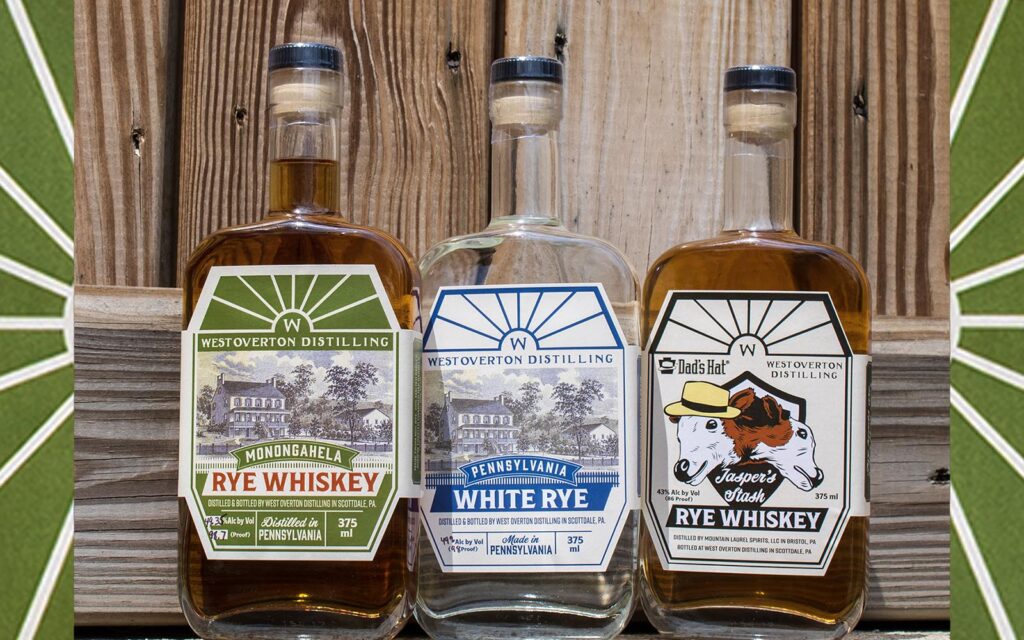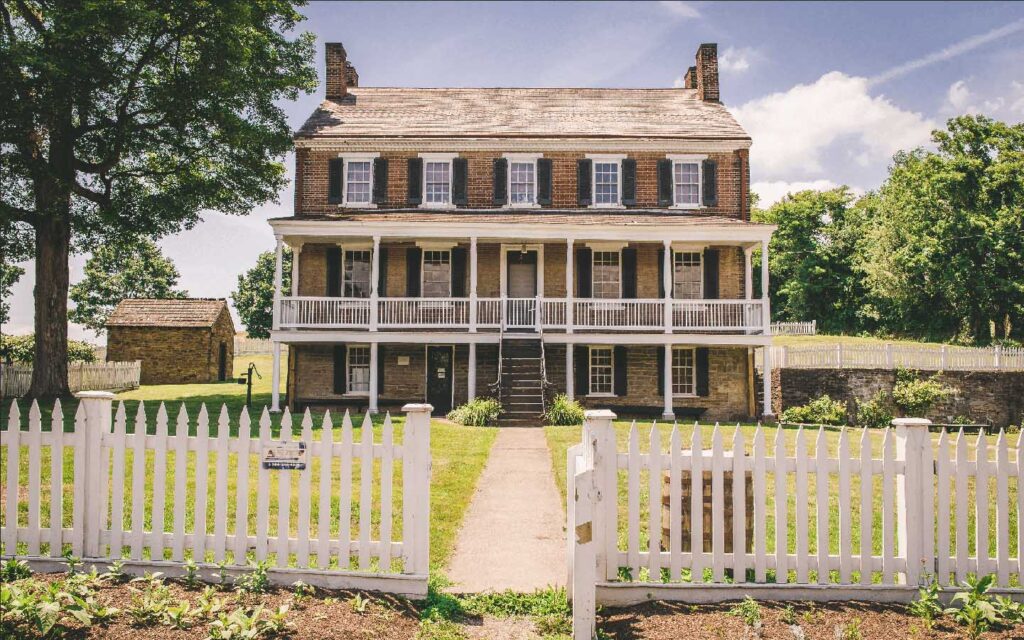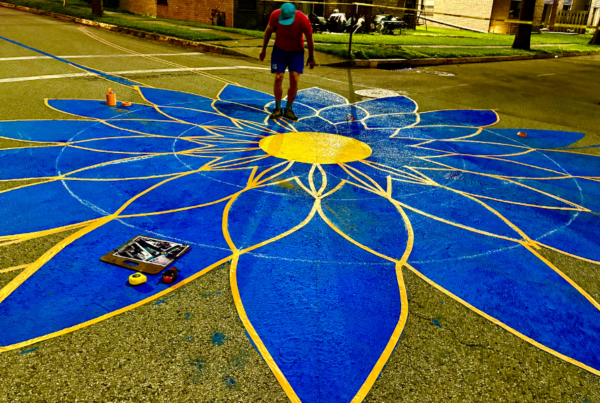
The West Overton Distilling Company, part of the West Overton Village and Museums
Community Spotlight—West Overton Village and Museums
The Community Spotlight series features the efforts Rivers of Steel’s partner organizations, along with collaborative partnerships, that reflect the diversity and vibrancy of the communities within the Rivers of Steel National Heritage Area.
By Gita Michulka, Contributing Writer
Finding Your Way to West Overton—New Exhibits and Wayfinding to Tell a Broader Story of the Overholt Homestead
In a nutshell, the West Overton Village and Museums (WOVM) is a collection of nineteen historic buildings nestled amongst thirty acres—the homestead of Abraham Overholt and birthplace of his grandson, Henry Clay Frick. The German Mennonite village was established in the early 1800s and soon blossomed into a hub of industry. And though the story of the Overholts is fairly well known, new exhibits and wayfinding are helping guests of the village explore how much more there is to the site’s history.
“This started as a family farm in 1803, but by 1880 it had just blossomed into this industrial community, built around a rye whiskey distillery, a grist mill, a coal mine, a coverlet weaving business, and all the auxiliary businesses needed to make all of this operate,” says Aaron Hollis, co-executive director of WOVM.
A lot is known, documented, and celebrated about the Overholt family. Visitors to West Overton can tour a museum dedicated to the industrial enterprises of the family, as well as walk through preserved rooms in the 1838 Overholt Homestead and tour the springhouse where Frick was born. But WOVM wanted to dig deeper and has recently unveiled a new exhibit that shines a light on the hundreds of residents who made a living as mill workers, coal miners, coopers, rail workers, and store clerks.
“You know, the Overholts are a wealthy, prolific, large family. Fricks, even more so. So people found their stories, their images, everything worth preserving. We have our museum, we have websites, we have photo albums—we even have albums of hair of the Overholts,” says Hollis with a laugh.
Hollis is eager to share more about the lesser-known residents of West Overton. “We were able to go through ledgers of the Overholt company store and pick out names. And as best we could, we researched these residents through tax records, through census records, what they bought and sold in the store—just trying to scrape together details of these people’s lives to try to tell stories of this community through their eyes and see how they were impacted and also impacted the industrialization happening around them.”
This new exhibit is now part of the permanent exhibitions at West Overton Village and Museums, and museum staff are hopeful that over the years, as people come to tour the site, they will recognize their ancestors on display and reach out to share more.

West Overton Distilling Company Products
Rye Whiskey at West Overton
The rebirth of an Overholt legacy is also on display these days at WOVM.
“We started making whiskey here on site in our new education distillery for the first time since prohibition,” says Hollis. “It had been a hundred years, almost exactly, from when the stills last ran here and when we were able to reopen a distillery here on site.”
Visitors can now tour the pre-Civil War stock barn that WOVM renovated to become the West Overton Distilling Company. And even though it is outfitted with brand new equipment, the style of whiskey that is being produced is a similar product to what Abraham Overholt and family would have enjoyed at the height of the region’s industrial era.
“It’s not like we could turn on a hundred-year-old still,” laughs Hollis. “But we are making a very similar style product—Monongahela Rye. And visitors can tour the distillery as part of their museum experience, sample the product, and buy cocktails and bottles as well.”
Wayfinding at West Overton
Hollis notes that guests are welcome to tour the grounds even when WOVM staff are not present. “If you come here on a day that we are closed, you can still walk around, read signs about the buildings, and still have a valuable experience, even if you’re not in person with a tour guide.”
A self-guided walking tour booklet is available for the site, which includes historical notes about the land and settlement along with particular attractions.
Thanks in part to funding from a Rivers of Steel Mini-Grant, WOVM has begun to implement the first phase of a wayfinding project that will enhance guest experiences both during and outside of museum hours. Signs will be installed to aid with parking and site directions, as well as signage on the main attractions for a more interactive and educational experience. Over time, the museum hopes to add more interpretive signs throughout the village that will highlight the key aspects of West Overton from a century ago for a more thorough understanding of WOVM, its history, and its relevance to the region.
No matter how you experience the attractions at West Overton Village and Museums, Hollis hopes you’ll take a minute to reflect on the spaces themselves. “The beautiful thing about this settlement is that these buildings—they’re all original, they’re all authentic. I think that’s what, in part, makes West Overton so unique—all the buildings that we have here are the original structures, and the site is in its original layout. When you tour the Homestead, you are sharing the floor with Abraham Overholt and Henry Clay Frick and people of the 19th century, and that really offers such a unique connection to our region’s past.”
West Overton Village and Museums is located in Scottdale, PA, and is open Thursdays through Sundays from 10am to 4pm (the last tour begins at 3pm). Visit westovertonvillage.org for more details and seasonal events.
All images courtesy of West Overton Village and Museums.
About the Mini-Grant Program
Rivers of Steel’s Mini-Grant Program assists heritage-related sites and organizations as well as municipalities within the Rivers of Steel National Heritage Area to develop new and innovative programs, partnerships, exhibits, tours, and other initiatives. Funded projects support heritage tourism, enhance preservation efforts, involve the stewardship of natural resources, encourage outdoor recreation, and include collaborative partnerships. Through these efforts, Rivers of Steel seeks to identify, conserve, promote, and interpret the industrial and cultural heritage that defines southwestern Pennsylvania.
The Rivers of Steel National Heritage Area is one of twelve supported by the Pennsylvania Department of Conservation and Natural Resources (DCNR). Funding is provided via DCNR’s Community Conservation Partnerships Program and the Environmental Stewardship Fund to Rivers of Steel, which administers the Mini-Grant Program. The Great Allegheny Passage Conservancy is one of eight organizations who received Mini-Grant funding through this program in 2022.
 Gita Michulka is a Pittsburgh-based marketing and communications consultant with over 15 years of experience promoting our region’s arts, recreation, and nonprofit assets.
Gita Michulka is a Pittsburgh-based marketing and communications consultant with over 15 years of experience promoting our region’s arts, recreation, and nonprofit assets.
If you’d like to know more about community projects supported by the Mini-Grant Program, read Gita’s recent article about the Great Allegheny Passage Conservancy.








